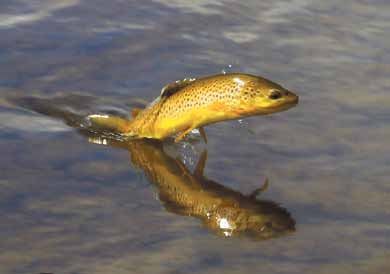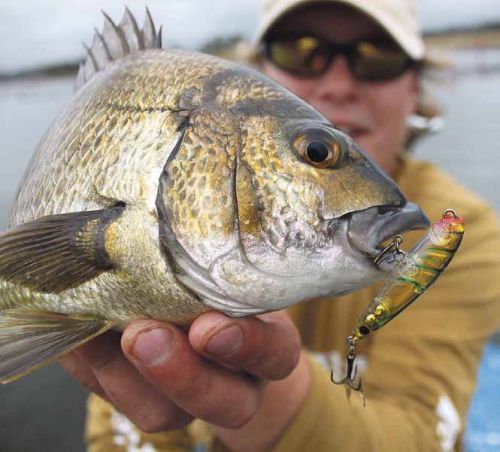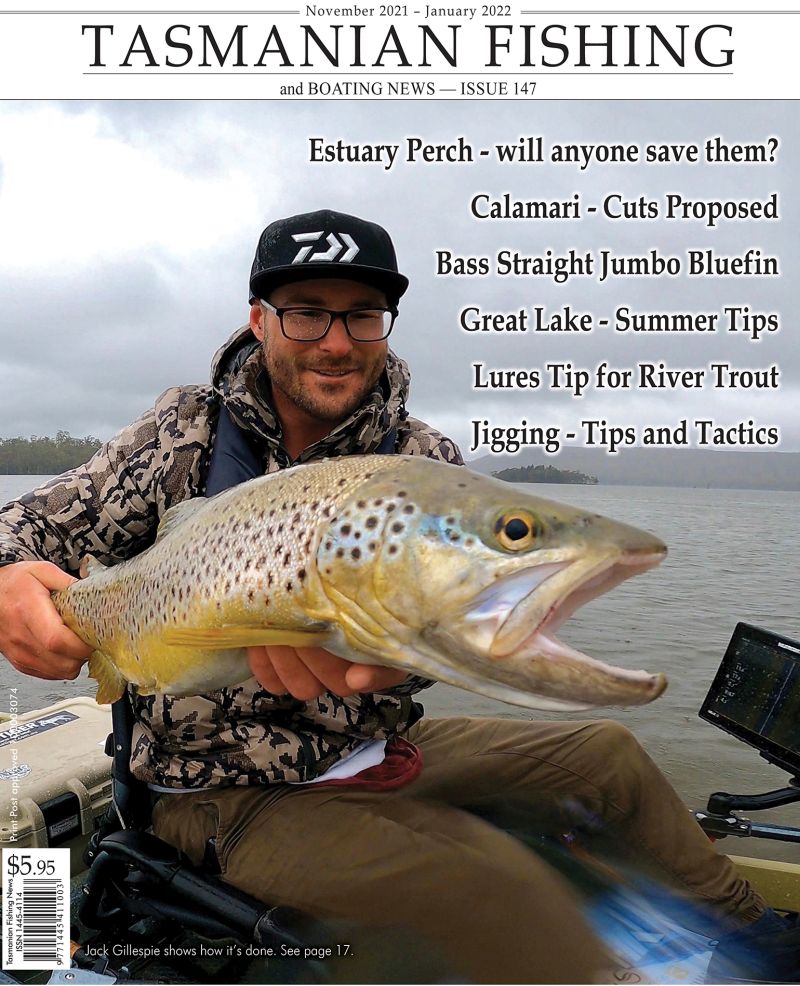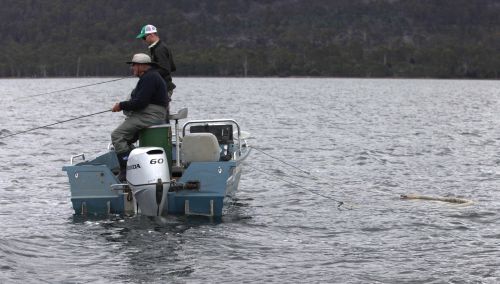From the Archives ...
Sea Trout Fishing - October and November
Sea Trout Fishing - October and November
Christopher Bassano
Fishing guide Christopher Bassano explores his favourite fishing-and shares a few tips that will help you discover the world of trout near the sea.
Please check all relevant authorities before fishing - www.ifs.tas.gov.au and dpipwe.tas.gov.au . Don't forget issuu.com/stevenspublishing for years of back issues !
Presented from Issue 97
Lake Mackintosh is your typical deep tannin stained West Coast Lake that was dammed in the 1980s to create the Mackintosh Power station. The lake has flooded up into native forest, limiting much of the shore access to the boat ramp area at the Mackintosh dam. To explore the full potential of this lake, you need a boat to access every corner. The lake is home to both brown and rainbow trout with it opening at the beginning of the brown trout season and finishing at the end of the rainbow trout season. The lake has a bag limit of 12 fish per person per day. To access the lake you need only drive to the town of Tullah via the Murchison highway and follow the signs.
- Written by Stephen Smith - Rubicon Web and Technology Training
- Category: Lake Mackintosh
- Hits: 7369
Presented from Issue 97
When people refer to the Western Lakes they are talking about a vast area of the central plateau that contains hundreds if not thousands of lakes. This area is made up of the central plateau conservation area and the Walls of Jerusalem National Park. This area and its fishing is truly unique in the world. The crystal clear waters and the ability to sight fish predominantly brown trout, at close range, amongst a unique landscape, is something that inspires many people to go to great lengths to explore and fish this region. Interestingly, the Western Lakes is not a place where you would go to catch a lot of fish in Tasmania. This is a place where less is more, with the ability to catch a large number of fish per day being gladly replaced with the chance of only catching a few quality fish. This is a place where there is a lake over every hill and where you get that rare opportunity to count the spots on a wild brown trout as it slowly swims past your feet.
- Written by Stephen Smith - Rubicon Web and Technology Training
- Category: Western Lakes
- Hits: 5642
Presented from Issue 97
The opening of the 2011/ 2012 trout fishing season had many anglers excited, rainfall had consistently inundated the state for months prior, and our inland catchments realised levels not witnessed for many years. That being said, the overall condition of many fish landed in the central highlands disappointed anglers, Arthurs Lake and Great Lake being two of the biggest offenders when it came to not “reaching expectations”. One Central Plateau fishery that seems to have bucked the trend this season was Lake King William, where if anything, the average size and condition of its inhabitants has increased quite dramatically. Todd Lambert, John Cleary and Mike Stevens recently took a trip up there to see if the rumours were true.
- Written by Stephen Smith - Rubicon Web and Technology Training
- Category: Lake King William
- Hits: 7898
 Presented from Issue 97
Presented from Issue 97
Most fisherman I know have a spot or two that when they go there they get that same sense of feeling that occurs when you arrive back home after a lengthy absence. One area that never fails to generate this nostalgic feeling for me is when I journey out to the two diminutive lakes located roughly north east of Arthurs Lake named Gunns Lake and Little Lake.
A chance meeting….
My Gunns and Little Lake odyssey started approximately 20 years ago on a calm and sunny September morning when long time fishing companion Todd Lamprey and I journeyed out to the two shallow natural lagoons on a purely exploratory mission. Todd and I had been in the highlands for a few days already on a multi day trip and we had decided on looking for a location for the days sport that didn’t require a lot of walking to get to. The preceding days had been spent hiking in the Western Lakes district and Todd and I both really needed to rest tired legs.
- Written by Stephen Smith - Rubicon Web and Technology Training
- Category: Other Lakes
- Hits: 7899
Read more: Gunns and Little Lake - Home of the Golden Bellied Brown Trout
Presented from Issue 97
For the past eight or nine years, game fishing in Tasmania has predominantly relied upon good numbers of southern bluefin tuna turning up in the south of the state. St.Helens, which for many years was the Mecca of game fishing slumped to the stage most anglers were heading south to get their “fix” or targeting other species instead.
- Written by Stephen Smith - Rubicon Web and Technology Training
- Category: Tuna Fishing and other Game Fishing
- Hits: 4671
Read more: The Best Game Fishing for many years is happening now...
Presented from Issue 97
What a fantastic year it has been already! The eastern side of the state has been producing some extraordinary fishing, including the appearance of some very solid striped marlin and yellowfin tuna. It would seem that the fishing has improved greatly since last year, as more and more big, trophy sized fish have been landed, lost or sighted. One thing I am really impressed with this year, is the size of the yellowfin that have been caught off the one and only game fishing capital of Tasmania, St. Helens! Not too long ago, I was lucky enough to have seen a huge yellowfin swimming beside our boat, the Terminator. Unfortunately though, for us, after a long battle on considerably heavy tackle, the line gave way and the fish was lost. Jamie Harris was on the rod, and I can assure you all right now, it was a very quiet few moments aboard the boat after the fish snapped the line and powered back off into the depths.
- Written by Stephen Smith - Rubicon Web and Technology Training
- Category: Tuna Fishing and other Game Fishing
- Hits: 5174
Presented from Issue 97
Before you charge into this article expecting to read about the best trout in Tasmania I should warn you that it relates to the highest ones not the fattest.
It is also fraught with danger to write about something that may not be totally correct as there are still a few remote tarns that I haven’t got to yet and probably never will. There are also some higher places I have found to be devoid of trout that some sneaky specimens may now have swam up into.
Having said all this it is my belief that the highest water in Tasmania to contain brown trout is an unnamed water at around 1290m south west of Turrana Heights. We have named it Lake Australia. It is a headwater tarn on one of several streams that flow into the western side of Pillans Lake. So drag out the Pillans 1:25000 map and follow the stream that runs up through Pencil Pine Tarn to a water roughly shaped like Australia. Now read on about how to get there and what to expect on the way. Maybe it is not for this season, but why not put it on the list for later in the year.
- Written by Stephen Smith - Rubicon Web and Technology Training
- Category: Trout Fishing
- Hits: 7374
Presented from Issue 97
Rebounding stocks of Eastern Australian Salmon along the eastern coast and a revealing study into the salmon’s life history have prompted Fisheries NSW to refine the balance between conservation, sport and industry.
Research findings from an FRDC-funded project have resulted in Fisheries NSW relaxing a 10- year restriction on the commercial take of Eastern Australian Salmon along the NSW coast, north of Barrenjoey Head.
The revised management code for northern NSW replaced a daily bycatch limit of 100 kilograms and permits allowing fishers to retain Eastern Australian Salmon as bait, with a 224-tonne-a-year commercial fishery as of 1 December 2011.
- Written by Stephen Smith - Rubicon Web and Technology Training
- Category: Australian Salmon
- Hits: 7772
Presented from Issue 96
Traditionally the age old art of fish taxidermy has involved the preserving, mounting and painting of the fishes skin and head to craft a life like trophy. In more recent times fibreglass fish reproductions or ‘repro’s’ have become available, offering the trophy hunter a viable alternative. Indeed, a well crafted repro can look as good and natural as a well made skin mount.
I was inspired to touch on this subject after hearing secondhand comments that ‘skin mounts don’t last!’ That’s true if the mount wasn’t made correctly in the first place. We’ve all seen the withered and colourless mounts hanging on pub and tackle shop walls, of hardly recognisable specimens caught 20 or 30 yrs ago, and in some cases not that long ago. Well, fish taxidermy has come a long way since those days, with modern techniques and products developed specifically for the industry there is no reason why a properly crafted skin mount should not last a lifetime.
- Written by Stephen Smith - Rubicon Web and Technology Training
- Category: Trout Fishing
- Hits: 17547
Read more: Fish Taxidermy Skin mounts vs Fibreglass reproductions
 Presented from Issue 96
Presented from Issue 96
I don’t think fishing gets any better than watching something come up to the surface and eat a lure off the top. If you’re like me and you love chasing those big Tasmanian bream on lures, then you might have considered casting a surface lure at one time or another. Plenty of people might tell you that “it’s a waste of time”, “black bream don’t like surface lures” or “the water is too cold down here”. Any other number of reasons not to do it might come up. I’m writing this article in the hope that I can disperse that myth and instil confidence in anyone who remains a sceptic. For last three years I have sought out bream on topwater lures in almost every recognised bream estuary, through every month of the year and in every weather condition. You might be surprised to learn that throughout this time I have had very, very few days where I didn’t get at least one fish.
Some days are definitely harder than others but in the end, good things come to those who wait. Hopefully I can pass on some information through this article that will help you in your search for that big topwater bream.
- Written by Stephen Smith - Rubicon Web and Technology Training
- Category: Bream
- Hits: 10310
Subcategories
Current TFBN
Click above for current issue content. The current issue of TFBN is extensive and topical. In Tackle Stores, Newsagents and by subscription.
Delivered to your door for $48 for 2 years (8 issues). To subscribe, send Mike $48 via www.paypal.com.au . (Basic instructions are here) The email is at Contact Us. Your address will be included from PayPal.
Or phone Mike with your c/c handy on 0418129949
Please ensure your details are correct, for Mike to organise delivery.
TFBN Newsletter Sign up Form
Why not submit an article ?
When you have finished for the day, why not have a brag about the ones that didn't get away! Send Mike an article on your fishing (Click here for contact details), and we'll get it published here. Have fun fishing - tasfish.com
Category Descriptions
Here is a list of all of the Article Categories. The number in Brackets, eg (13) is the number of articles. Click on Derwent River and all articles relating to the Derwent will be displayed in the central area.
Articles by Category
-
Rivers (3)
-
Saltwater and Estuary Fishing (149)
-
Kayak Fishing (34)
-
Lakes (1)
-
Great Lake (62)
-
Lake Leake (52)
-
Woods Lake (16)
-
Lake Augusta (11)
-
Huntsman Lake (13)
-
Lake Pedder and Gordon (10)
-
Lake Dulverton (5)
-
Lake Crescent (6)
-
Tooms Lake (10)
-
Lake Mackintosh (2)
-
Lake Barrington (5)
-
Little Lake (8)
-
Meadowbank Lake (5)
-
Lake King William (7)
-
Lake St Clair (2)
-
Western Lakes (12)
-
Arthurs Lake (35)
-
Lake Echo (7)
-
Four Springs (54)
-
Lake Sorell (7)
-
Lake Burbury (6)
-
Other Lakes (57)
-
Brushy Lagoon (18)
-
Little Pine Lagoon (5)
-
Penstock Lagoon (16)
-
Brumbys Creek (7)
-
-
Events (48)
-
Estuary Fishing (0)
-
Coastal Catches (46)
-
Super Trawler (46)
-
IFS, DPIPWE, MAST and Peak Bodies (435)
-
Commercial Interests (98)
-
Other (24)
-
TFBN Back Issues (8)
-
Fly Fishing (67)
-
Trout Fishing (252)
-
Meteorology and Weather (8)
-
Jan’s Flies (50)
-
Tuna Fishing and other Game Fishing (86)
-
Cooking Fish (19)
-
Fishing Information (1)
-
Fishing Books (8)
-
Videos (5)
-
Tackle, Boats and other Equipment (146)
-
World Fly Fishing Championship 2019 (2)
Popular Tags
windyty.com
Visit https://www.windyty.com/
Rubicon Web and Technology Training
Hello everyone, I thought it would be a good time to introduce myself.
My name is Stephen Smith and I have been managing the website tasfish.com since May 2009.
It has been an epic journey of learning and discovery and I am indebted to Mike Stevens for his help, support and patience.
I am developing a new venture Rubicon Web and Technology Training ( www.rwtt.com.au ). The focus is two part, to develop websites for individuals and small business and to train people to effectively use technology in their everyday lives.
Please contact me via www.rwtt.com.au/contact-me/ for further information - Stephen Smith.
From the Archives ... (last chance)
Sea Trout Fishing - October and November
Sea Trout Fishing - October and November
Christopher Bassano
Fishing guide Christopher Bassano explores his favourite fishing-and shares a few tips that will help you discover the world of trout near the sea.



